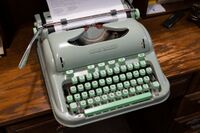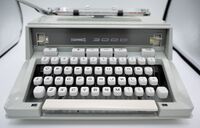Hermes 3000
History and Basic Info
The Hermes 3000 is a line of typewriters made by Paillard S.A. from 1958 through approximately 1979, although information is sparse about the latter years. Produced in three distinct generations, the earlier ones have become quite desirable (and expensive) thanks to the seal of approval from Tom Hanks.
The first generation, produced from 1958 through 1965/66 has a distinct 'curvy' look, and a metal shell. These were made in Switzerland. The second generation, produced from 1966 through 1970 are more squared off, but still retained a metal shell and were still made in Switzerland. The third generation, produced from 1970 until the end of production in the late seventies are very boxy and have a plastic shell. It retained all of the features of the earlier models but was a cost-reduced version, and production was shifted to France.
Common Issues
The flip-out paper rest on the back of the carriage can get stuck in the closed position, due to deteriorated self-adhesive foam pads that just turn into glue over time. Then, when someone attempts to flip the paper rest fingers out while one is stuck, one of them will tend to get bent, as they are linked together.
The platen knobs on the first and second generation Hermes 3000 machines are notoriously fragile, and are often cracked or broken. Replica replacements are available from a number of sources online, although quality may vary.
The rear panel of the carriage, to which the paper rest is attached may be loose due to missing screws. It is secured to the machine by a pair of M3x0.5 pitch screws, 5mm in length with slotted pan heads. Screws matching this spec are quite readily available in most hardware stores, although you may have to settle for philips vs slotted, or flat head vs pan. In that case, it would be recommended to use a washer so that the conical flat head doesn't damage the hole on the back of the carriage end caps.

